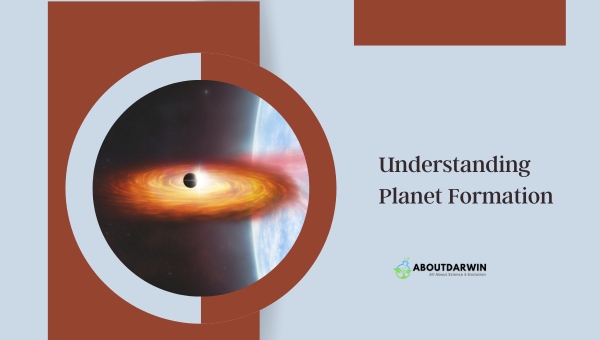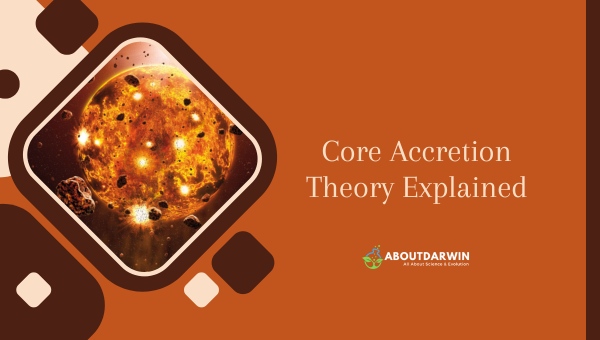Physical Address
304 North Cardinal St.
Dorchester Center, MA 02124
The complexities of how planets form is a captivating journey. Central to this exploration is the core accretion theory, which posits that planets develop through the gradual accumulation of solid particles in a protoplanetary disk.
This theory not only sheds light on the origins of our solar system but also offers insights into the formation of exoplanets.
As we delve deeper into this fascinating subject, we uncover the intricate processes that govern planetary birth and evolution, revealing a universe rich with cosmic wonders waiting to be understood.
Contents
The formation of planets is a complex process that has intrigued scientists for centuries. How planets like Earth came into existence provides insight into our solar system’s history and the broader universe.

Here is a summary of the different growth phases in planet formation:
| Growth Phase | Description |
|---|---|
| Dust Growth | Centimeter-sized particles form. |
| Runaway Growth | Kilometer-sized planetesimals form rapidly. |
| Oligarchic Growth | Protoplanets form by collisions of large bodies. |
The prevailing theory is that planets formed from a rotating disk of gas and dust surrounding a young star, a process that began approximately 4.6 billion years ago.
This phenomenon is not only crucial for understanding our own planet but also for exploring the potential for life on other worlds.
The solar system originated from a solar nebula, a vast cloud of gas and dust left over from the Big Bang.
Approximately 4.6 billion years ago, this nebula began to collapse under its own gravity, possibly triggered by a nearby supernova explosion. As the material collapsed, it spun faster and flattened into a protoplanetary disk around the newly forming Sun.
Accretion Process: Within this disk, particles of dust began to collide and stick together due to gravitational attraction, forming larger bodies known as planetesimals.
Over millions of years, these planetesimals continued to collide and merge, eventually forming protoplanets—the building blocks of the planets we know today.
The process of accumulation through collisions is termed accretion.
The temperature gradient in the early solar system played a significant role in determining the types of planets that formed.
The inner solar system was much hotter, allowing only materials with high melting points—like metals and silicates—to remain solid. This led to the formation of terrestrial planets such as Mercury, Venus, Earth, and Mars, which are rocky and smaller.
In contrast, the cooler outer regions allowed for the formation of gas giants like Jupiter and Saturn, which could attract and retain large amounts of hydrogen and helium due to their greater mass.
Recent studies suggest that planetary migration occurred after initial formation. Gravitational interactions among protoplanets could have caused them to move closer or further from the Sun over time. This migration may have contributed to the current arrangement of planets in our solar system.
Additionally, collisions among celestial bodies continue to shape the solar system, leading to the creation of moons and other small bodies like asteroids and comets.
Planet formation not only sheds light on our own solar system’s history but also assists astronomers in identifying exoplanets around distant stars, enhancing our knowledge about potential habitable worlds beyond Earth.
Also Read: Why Does the Earth Hum? Exploring the Science Behind It
The Core Accretion Theory is a well-established scientific model that explains the formation of planets in our solar system, particularly focusing on how solid and gaseous bodies coalesce from a primordial cloud of gas and dust.

This theory emphasizes the gradual accumulation of material through gravitational attraction, leading to the creation of diverse planetary bodies.
This process, we gain insights into not only our own planet’s origins but also the formation of other celestial bodies in the universe. The core accretion model serves as a foundational framework for this understanding.
The formation process can be broken down into several key stages:
The core accretion model provides a comprehensive framework for understanding how planets are formed and highlights the significance of gravitational forces in shaping our solar system’s structure.
| Feature | Description |
|---|---|
| Initial Material | Cloud of gas and dust (protoplanetary disk) |
| Planetesimal Size | Ranges from meters to hundreds of kilometers |
| Critical Mass for Gas Giants | 5-10 times Earth’s mass |
| Accretion Phases | Slow initial growth followed by rapid gas envelope accretion |
This theory helps explain not only terrestrial planets but also gas giants and their unique compositions.
By integrating these concepts, we can better appreciate the dynamic processes that govern planetary formation throughout the universe.
Also Read: Top 10 Fascinating Facts About Uranus
The core accretion model is a widely accepted theory explaining the formation of planets, particularly gas giants, in our solar system and beyond.
This model outlines a multi-step process where solid materials gradually accumulate around a central core, leading to the development of larger planetary bodies.
The core accretion model has gained support from various observations and simulations, making it a crucial framework for understanding planetary formation.
The core accretion model describes the process of planet formation beginning with small solid particles, such as dust grains and ices, which collide and stick together. This initial phase involves the following stages:
The core accretion model provides insights into the composition and distribution of planets in our solar system.
For instance:
The core accretion model remains a foundational concept in planetary science, helping researchers understand not only our solar system’s structure but also the characteristics of exoplanetary systems across the galaxy.
The exploration of the core accretion theory reveals significant insights into how planets form from dust and gas in protoplanetary disks. This theory posits that solid particles gradually coalesce through gravitational attraction, leading to the creation of planetesimals and eventually full-fledged planets.
While challenges such as the meter-size barrier exist, ongoing research continues to support the core accretion model as a fundamental framework for understanding planetary origins.
As our observational technologies advance, we can expect further revelations about the complexities of planet formation and the dynamic processes that shape our universe.